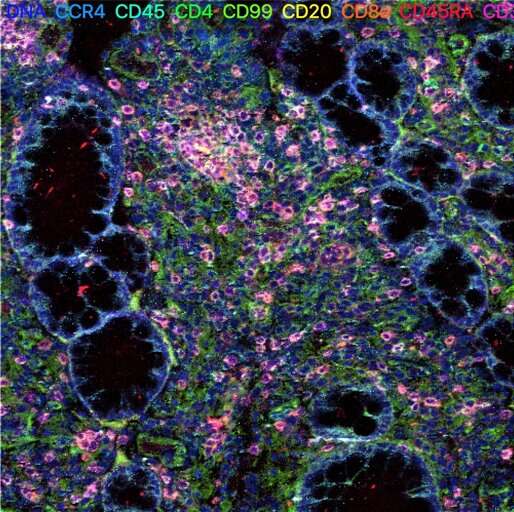Researchers use unique imaging technology to map cells tied to inflammatory bowel disease


New “maps” of hundreds of thousands of cells related to inflammatory bowel disease shed greater light on their effects on intestinal tissues through a newly utilized imaging technique called imaging mass cytometry. The novel findings by researchers at the Perelman School of Medicine at the University of Pennsylvania provide a possible path to better targeted and more personalized approaches to treating inflammatory bowel disease (IBD). The researchers’ work was published in Gastroenterology.
Estimated to affect nearly seven million people worldwide, IBD is a catch-all term that covers multiple disorders involving inflammation of the gastrointestinal tract. Most cases are of Crohn’s disease or ulcerative colitis, which have different clinical presentations and tend to affect the gut in different patterns. However, there is enough symptom overlap that the two diseases can be challenging to distinguish.
Treatments that target specific immune signaling pathways are available for both disorders, but they don’t work to the same degree for every patient, and can have adverse side effects, including an increased risk of infections.
“To develop better treatments and better ways of diagnosing IBD we need to gain a more complete understanding of this set of disorders at the cellular and molecular level, and this study demonstrates a powerful new way of doing that,” said the study’s senior author, Klaus Kaestner, Ph.D., a professor in Genetics.
Traditional pathology methods have been limited in what they can reveal in biopsied intestinal tissue from IBD patients, as they can measure only a handful of protein markers, making it hard to distinguish all relevant cell types in detail. By contrast, imaging mass cytometry uses a collection of specially designed antibodies that bind to more than 30 distinct antigens—the molecular substances that trigger the body’s immune response—enabling researchers to map all cell types in a given patch of tissue at high resolution.
Kaestner’s team, including first author Ayano Kondo, a graduate student in his laboratory who performed most of the analyses, applied the new imaging method to six intestinal tissue samples from Crohn’s patients and six from ulcerative colitis patients, comparing these to samples from healthy individuals. The resulting cellular maps, the first of this kind in IBD research, covered hundreds of thousands of individual cells—and provided many new details of how IBD disrupts intestinal tissue stability. Intestine-lining epithelial cells, for example, were multiplying more rapidly in the IBD tissue compared to healthy tissue, and were more likely to express the immune system component HLA-DR, which can help activate an inflammatory response by the immune system. These features correlated with the degree of inflammation in both diseases.
The mapping also detailed the presence in the diseased tissue of T-reg cells—regulatory immune cells that normally help control inflammation—and suggested that between Crohn’s disease and ulcerative colitis there are specific differences in the patterns of other immune cell types with which T-regs interact.
Source: Read Full Article